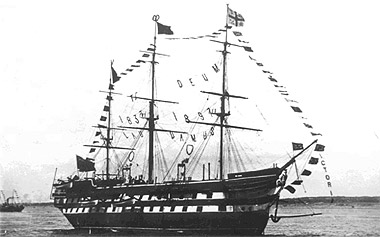
| HOME |
| NERVE |
| REVIEWS |
| ARCHIVE |
| EVENTS |
| LINKS |
| ABOUT US |
| CONTRIBUTORS |
| BACK ISSUES |
| CONTACT US |
Back to index of Nerve 17 - Winter 2010
 In February
1911 the denial by Winston Churchill of brutality at a Merseyside borstal
highlighted the sorry tale of the:
In February
1911 the denial by Winston Churchill of brutality at a Merseyside borstal
highlighted the sorry tale of the:
Savage Ships of the Mersey
From quarantine to borstal, ships in the Mersey hide stories of misery,
sickness and brutality.
In the 1830s the Akbar (right) was moored off Rock Ferry as a quarantine
ship for cases of bubonic plague, cholera, typhus and smallpox.1
In 1856 it became a floating borstal for Protestant boys aged 11-15 (the
Clarence became a Catholic borstal a few years later). The Recorder of
Liverpool reported in 1866, "The two Reformatory ships have succeeded
to a very large extent in clearing the town of juvenile crime".
Conditions on these ships were extreme. In winter the boys suffered from
chilblains, tuberculosis, pneumonia and asthma.2
Horrendous accidents have been described in the old Minute Books of the Akbar: One boy "while employed in blacking a portion of the rigging was accidentally jerked off and thrown down from a height of 16 feet on to the deck, dying three hours later..." Another "fell from the main top deck and received concussion and partial jaw fracture, was recovering ..." Yet another "while manning the working boat, slipped and was crushed between the boat and the ship side. His body was washed up on shore ..."
Physical punishment included birching and caning. In August 1872, one lad was so worried about this that one night he clambered down to the bottom of the accommodation ladder to wash out his blanket before official inspection. He overbalanced and fell into the Mersey. His body was never found.
The Akbar moved to land and became Heswall Reformatory School on 2 December 1907. But the ill treatment continued. John Bull magazine exposed this in 1910 with the headline: "Reformatory School Horrors - How Boys at the "Akbar" School are Tortured - Several Deaths".
Winston Churchill assured Parliament that there was "no proof whatever" they were being mistreated. Nevertheless he set up an investigation into the incidents.
Boys had been gagged before birching, sick boys caned for malingering. No less than 27 had permanent scars from beatings. Others had been made to stand all night as a collective punishment. There had been four deaths in 1909: a boy called Brooks, who was going to be caned on the day he died, even though he was ill. Brown was drenched with water and died twenty minutes later. Mills just collapsed and died. Yeadon was, "a weakly boy - probably a boy of degenerate type, utterly unfit for sea-life or ordinary industrial training."
Despite all the criticisms the inquiry did not recommend any changes, although the Chief Officer resigned. John Bull reported reprisals against boys who had given evidence.
- Between 1824 and 1863 there were at least ten quarantine hulks moored off Rock Ferry - at one stage six were there simultaneously.
- There were actually four ships off Rock Ferry. The other two were The Conway (1859) used for the training of officers in the Merchant Navy, and The Indefatigable (1865), a school for destitute and orphan boys from Liverpool.
Sorry Comments Closed
Comment left by bob miles on 24th July, 2011 at 13:00
Caning and birching was still being used in Approved Schools and Borstals well into the 1960s